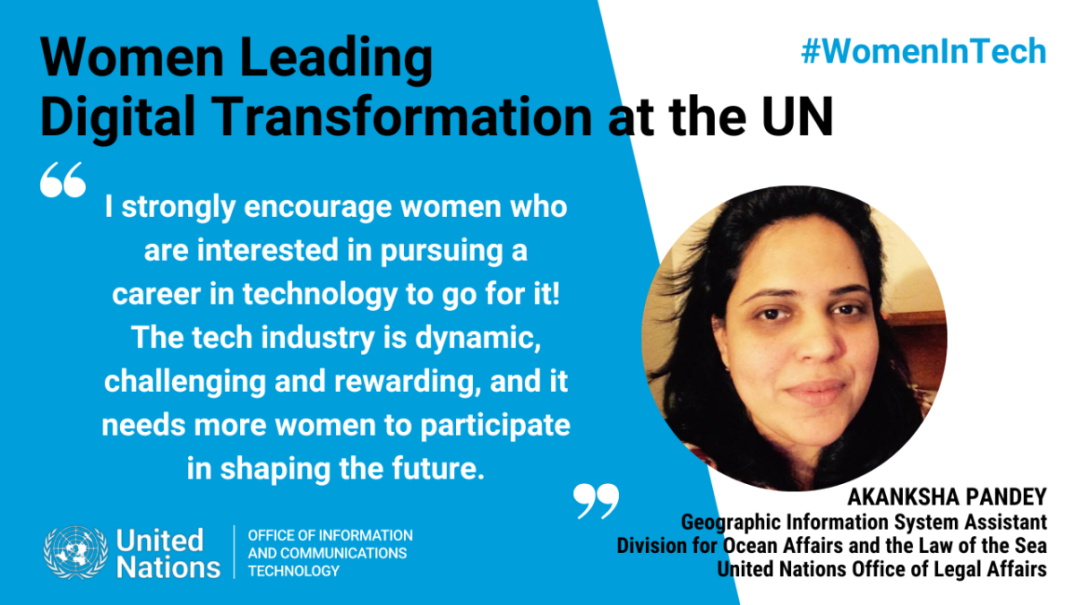Read about Akanksha Pandey


Akanksha Pandey
Geographic Information Systems Assistant
Division of Ocean Affairs and the Law of the Sea, Office of Legal Affairs
What brought you to a career in technology at the United Nations?
Career in technology at the United Nations has been a marriage of my 2 passions working in technology and working for an international organization. I have a background in computer science, software engineering, data analysis, project management, or other relevant fields. I have worked in the private sector or for other international organizations before joining the UN.I have specific expertise in areas such as databases and Business intelligence, or emerging technologies. In addition to technical skills, individuals working in technology at the United Nations also need to have a strong understanding of the UN's mission and values, as well as the ways in which technology can be used to support that mission. I am able to work collaboratively with colleagues from diverse backgrounds and cultures, and be able to communicate technical information clearly to non-technical stakeholders. Overall, a career in technology at the United Nations has been a rewarding and challenging way to contribute to global development and keeping efforts, and can provide opportunities to work on a wide range of important initiatives.
What has been your favorite IT project at the United Nations and what was your technical contribution?
Migration from Nucleus to Umoja ERP has been my favorite project although it was a complex process that required careful planning and execution. The United Nations embarked on the Umoja ERP project to modernize and harmonize its administrative systems, including finance, human resources, and supply chain management, and replace the many outdated and disparate systems that were previously in use. The move from Nucleus to Umoja ERP involves migrating a large amount of data, including financial and personnel data, from one system to another, and ensuring that the new system is configured to meet the specific needs of the organization. The migration process involved the following steps: Planning: This involves developing a detailed project plan that outlines the scope of the migration, the timeline, and the resources needed. This involved identifying any customizations or interfaces that need to be built to ensure a smooth transition. Data cleansing: Before the data was migrated, it was reviewed and cleansed to ensure that it is accurate and consistent. This involved identifying and resolving data quality issues, such as duplicate or incomplete records. Data migration: The data was migrated from Nucleus to Umoja ERP using a variety of tools and techniques. This involved extracting the data from the old system, transforming it into the format needed for the new system, and then loading it into the new system. 4 Configuration and testing: Once the data was migrated, the new system needs to be configured and tested to ensure that it is working as expected. This involved configuring workflows, roles and permissions, reports, and other system settings. 5 Training and rollout. Overall, the migration from Nucleus to Umoja ERP is a complex process that requires significant planning, resources, and expertise. However, it was a critical step in modernizing and improving the United Nations' administrative systems, and can help to improve efficiency, reduce costs, and enhance transparency and accountability.
What advice would you give women interested in pursuing a field in technology?
I strongly encourage women who are interested in pursuing a career in technology to go for it! The tech industry is dynamic, challenging, and rewarding, and it needs more women to participate in shaping the future. Here are some pieces of advice that may be helpful: 1. Find a community: Look for groups of women in tech, whether they're online or in person, to connect with and share experiences. This can be an excellent source of support and advice. 2 Get involved: Attend tech events, join hackathons, and contribute to open-source projects. This can help you build your skills and connect with others in the industry. 3. Develop your skills: Learn programming languages, build projects, and seek out mentors to help you develop your technical skills. There are many resources available online to help you get started. 4. Network: Build relationships with people in the tech industry, including recruiters, potential employers, and colleagues. Attend career fairs, use LinkedIn to connect with others, and join professional organizations. 5. Be confident: Believe in yourself and your abilities. Don't let imposter syndrome hold you back. Women have the potential to be successful in the tech industry, and your unique perspective and skills can be a valuable contribution. 6. Seek out role models: Look for women who have succeeded in tech and learn from their experiences. Seek out mentors and allies who can support you and provide guidance. 7 Be persistent: The tech industry can be competitive and challenging, but don't give up. Keep pushing yourself and working towards your goals. Remember, the tech industry needs more diversity, and women have an important role to play in shaping the future of technology. Don't be afraid to pursue your dreams and be part of this exciting field!


